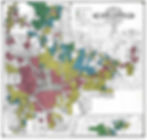Running Against the Odds: The Legacy of Redlining in the United States 🏃🏾♀️
- Danait Issac
- Aug 6, 2024
- 3 min read
August 2024

Yall know why we’re tuning in for the Summer Olympics: two words—Sha’Carri Richardson! With her dazzling nails and vibrant hair, Richardson shattered the fastest women’s 100-meter time in the world this year at 10.71 seconds. And, of course, watching Simone Biles secure yet another gold medal (as if she ever had real competition, pffft) is a must see.
But as we celebrate these phenomenal athletes, it’s also important to address why outdoor spaces like the Summer Olympics often lack diversity. Systemic issues, including the United States' legacy of redlining and discriminatory policies, have long deprived Black and Brown communities of access to recreational facilities, green spaces, and even clean air.
Here's what they don’t teach us at school…
Segregation may have “officially” ended with the signing of the Civil Rights Act of 1964, but discriminatory practices did not disappear overnight. In fact, many big corporations and government entities found loopholes in federal policies that allowed them to continue discriminating against Black and Brown communities. A prime example of this is redlining.
Redlining was the illegal practice of denying people living in a certain area or neighborhood access to loans and other credit services on the basis of race. Redlining maps, originally created by the Home Owners' Loan Corporation in the 1930s, used a color-coded scheme to indicate lending risk. Green areas were deemed favorable for lending, while red areas, which were predominantly Black and Brown communities, were marked as high-risk. Insane, right? The mere presence of Black residents in a neighborhood would label it as “high risk”. As a result, banks and insurance companies would refuse to insure mortgages in redlined areas, making it nearly impossible for Black residents to obtain loans or invest in their homes.

This practice fueled the concentration of poverty and disinvestment in Black and Brown communities. Redlined areas became targets for the imposition of federal highways and as sites for landfill and incineration companies.
You can explore maps from your own city here.
Jumping those High Hurdles
Sixty years later, the impact of redlining is still felt today. In 2022, a Black professor at John Hopkins appraised his house and saw a $289k difference in value after removing family photos, revealing how the housing market continues to undervalue Black properties. In the South, redlined areas remain the most segregated by race and suffer from long term health challenges. Historical redlining is linked to increased risk of diabetes, hypertension, and early mortality. These neighborhoods often lack essential amenities like swimming pools, parks, sidewalks, libraries, fresh produce, and other fundamental building blocks for a safe and healthy living.
Life is a marathon, not a sprint

Even though the history of redlining is often overlooked, stories of Black joy and resilience are even less well known. HBO’s Lovecraft Country depicts a family traveling through segregated America in search of a missing father and to write editions of The Green Book, a guide for Black families to find safe places to vacation, eat and sleep during the Jim Crow era. This book was real! The Negro Motorist Green Book was the most popular guide for black travelers for almost 30 years. One of the locations featured South Carolina’s Atlantic Beach that was founded by George W. Tyson, a Black businessman who had paid $2,000 for 47 acres of oceanfront land in 1934.
Inspired by the work of Martin Luther King Jr., the National Parks service created a summer camp program for Black youth from DC at Catoctin Mountain Park offering camping, fishing, hiking, and swimming.
Today, here are some organizations that continue the spirit of The Green Book:
Outdoor Afro: A national organization with chapters across the U.S. that organizes outdoor experiences for Black communities
All Kids Play: Provides athletic gear, apparel, and footwear to organizations serving youth ages 3-18 in high-need communities
SwemKids: A nonprofit program based in Metro Atlanta that provides free swimming gear and lessons to low-income communities with the highest rates of drowning, having served over 2100+ Black youth
Black Girls Run: An national running organization with ambassadors in over 30 states, encouraging Black women to stay healthy and active
Although Richardson experienced a setback in 2023, her determination reminds us that everyone, regardless of their race, gender, or orientation, deserves the opportunity to compete and succeed without facing systemic hurdles.
